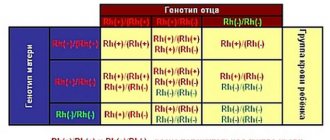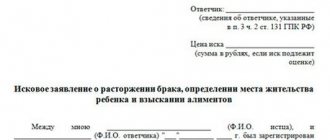Legal advice > Family law > How to determine paternity without DNA: different methods and methods
It is important for any person to know who his real parents are, and everyone also wants to be sure that he is the child’s parent. For various reasons, a mother or father may doubt the reliability of paternity and are looking for a way to confirm or refute this fact.
Quite often there are situations in which a mother cannot absolutely accurately name the biological father of her child, since in a short period of time she had sexual intercourse with more than one partner. Everyone knows that a definite answer can be obtained by conducting a medical DNA test, but not everyone has the financial opportunity or desire to conduct it.
But are there other ways that can help find out accurate paternity information? Such an action is real, although finding out will be much more difficult to carry out, and the result can only be called approximate.
About the test. A little science
When a child is conceived, he receives half of the chromosome set from the father and half from the mother. All people have 23 pairs of chromosomes, one pair of which are sex chromosomes, and 22 pairs of autosomal pairs, which contain autosomal markers. Markers are sections of DNA with a very specific localization, i.e. geneticists know exactly where the genes they need are located.
The test is carried out precisely on these autosomal markers. The DNA of the father and the child is analyzed and then compared to each other. As a rule, 16 markers are enough. If everything matches, then paternity is absolutely confirmed. If 2 markers do not match, then paternity is definitely excluded. If 1 marker does not match, then this may be a gene mutation and it is advisable (but not necessary) to analyze the mother’s DNA.
How a DNA test is done: stages of implementation
DNA tests are very diverse, but the procedure for carrying them out follows the same principle. There is a common chain of events that not all tests pass: for example, to detect the presence of viruses and infection in a sample, there is no need to sequence DNA, but rather identifying one foreign molecule in the sample is sufficient.
- Collection and receipt by the laboratory of a biospecimen for research.
- Isolation of cells from a sample and their synthesis by polymerase chain reaction. At this stage, the number of deoxyribonucleic acid molecules required for testing is created.
- Sequencing is the determination of the gene sequence in a DNA molecule.
- The areas of genes required for research are tinted with fluorescent dye.
- The tinted gene regions are exposed to a targeted laser beam, allowing precise visualization and examination.
- Decoding the received data and writing medical recommendations.
Anonymous paternity determination
It is not uncommon that paternity must be determined as “quietly” as possible. Nobody wants to start a scandal ahead of time. And if everything is confirmed, then forget this story altogether and move on with your life. In such cases, an anonymous paternity test can be performed. Any information you do not want to include can be omitted. It is enough just to write the degree of relationship (father, child) on the envelopes with samples.
A laboratory that understands the full degree of responsibility and values its reputation securely stores client data on closed servers. And to identify analyses, random combinations of numbers are used - order numbers. You can be sure of the confidentiality of all personal data.
DNA samples in the case of an anonymous paternity test may be different. It is extremely difficult to take an oral swab without being noticed, so non-standard samples come to the rescue. In any, absolutely any biological sample, the DNA is the same and there is no difference from which part of the body the DNA is taken. The accuracy of the paternity test will always be the same, up to 99.99999% for a positive result and 100% for a negative one. Here is an example of the most available non-standard samples:
- Hair with roots;
- A comb if it was used by one person.
- Toothbrush.
- Nails.
- Earwax.
- Razor.
- Cigarette butts.
- Chewing gum.
- Stains on underwear and clothes.
- Snot (but green, transparent liquid ones will not work).
- Blood stains.
- Cutlery, incl. cups.
- Toothpicks.
- Used condom.
These are the most frequently encountered samples in genetic practice. Of course you can expand the list. Qualified laboratory specialists can help with this.
How to find out if it's really his child
Do you want to know if he is really the father of your child? Doubts about paternity can be consuming and infect the precious time you spend with your child. Today there are many options for determining the paternity of a child. Below are some tips to guide you through this difficult process.
Learn about non-invasive prenatal options for paternity testing. If you are pregnant and unsure who the baby's father is, paternity can be determined before the baby is born. In some tests, it is possible to obtain a sample of the baby's DNA even while he is still in the womb. However, it should be noted that these methods require the father to provide a sample of his DNA (usually a cheek swab or a blood sample). Of all the prenatal paternity testing options, non-invasive prenatal paternity (NPP) testing is the least stressful for the baby. This test does not involve taking a DNA sample directly from an unborn baby. A sample of the mother's blood will likely be needed. The baby's DNA found in the mother's blood is analyzed and compared with the potential father's DNA.
You may be interested in:: Best Areas of Nice to Live in Rental Apartments
Establishing paternity for the court
Unlike the information test, the judicial test cannot be performed confidentially. The court will reject such a conclusion. That a DNA paternity test had legal force and served as irrefutable evidence in court, you need to go through a strictly regulated procedure and provide the necessary documents. Below we will consider in detail the types of forensic tests and what is needed to obtain a forensic genetic examination for paternity.
Types of forensic analyzes
Until the court's decision. If a court has not yet been appointed and you only plan to file a claim, you can independently choose a laboratory for analysis. This is very convenient, because... Only you decide where to turn. After going through all the identification procedures, you will be given a full legal opinion from a forensic medical examination. With this conclusion you can go to court and win your case.
By the tribunal's decision. If the court has already appointed a specific laboratory to conduct a judicial paternity test, then there is no other alternative. You will have to contact this organization. However, it is possible to achieve the desired court decision. To do this, you need to submit a request (petition) in advance to schedule a paternity examination at a laboratory convenient for you. Competent laboratory experts will help you draw up such a request or send it by email.
The procedures for collecting samples and identifying study subjects are exactly the same for both forensic and court-ordered investigations. The expert opinions are also completely the same.
Procedure and required documents
Since the conclusion will be submitted to the court and a decision will be made on its basis, it is necessary to prepare documents and appear in person for the collection of samples for all participants in the analysis for identification. It is not necessary for everyone to come together, but everyone must show up.
Documents must be originals. Copies of originals are also allowed, but this fact will be reflected in the laboratory report. Only the judge can decide whether this will affect the court's decision.
Adult children (18 years and older and adults) must bring original passports with them. If the person is a citizen of a foreign country, then an original foreign passport or identification card with a photo and full name.
Minor children must have their original birth certificate with them. If the child is a citizen of a foreign country, then a document replacing a birth certificate in this country.
ATTENTION! If it is not possible to provide these documents, then other papers and cards identifying a person may be suitable. For consultation, you must contact a DNA laboratory specialist.
Sample collection and identification procedure
Below we describe “step by step” the entire process of submitting biological material for a judicial test to establish paternity:
- Identification. The specialist will visually check the documents of all study participants. He asks: “Are these your documents?” and “What is your name?” Next, the documents are photocopied and the photocopies are signed by their owners. A parent or legal guardian signs for children. After this, the specialist certifies all photocopies with his signature and company seal.
- Taking photographs. Each study participant and parent/guardian is photographed. Photos are printed and signed by the person depicted in the photo. A parent or legal guardian signs for children. After this, the specialist certifies all photographs with his signature and company seal.
- Biological material is collected. The expert takes a mouth swab from all individuals being examined. ONLY an expert can carry out the fence. It is strictly forbidden to bring samples with you. Envelopes with samples are sealed with the expert’s signature and the company’s seal.
- Protocol. A protocol for collecting biological material is drawn up. It indicates all the individuals from whom samples were taken and each of them signs that he has no complaints about the method of collecting samples. At the end, the specialist signs.
- Information consent to the processing of personal data is issued for each participant. This is the standard form.
On this, clients can be free. As a rule, this entire procedure takes 30-40 minutes. The expert completes the design. He puts all the documents and samples into one large paper envelope, seals it, puts his signature and the company seal on the fold. This envelope is then sent directly to the DNA laboratory for testing.
What signs can be used to determine paternity without DNA?
- Prepare: a new package of cotton swabs, medical gloves, 2 sheets of paper, 2 postal envelopes
- An hour before collecting saliva, do not smoke, do not eat, do not brush your teeth, drink only water, and immediately before collection, rinse your mouth with plain water.
- Put on gloves, open the package of sticks, take out 2-3 pieces, cut off one cotton tip from each.
- Holding the cut end of the stick, rub it lightly along the inside of your cheek for 10 seconds.
- Place the stick on a piece of paper to allow the sample to dry. Do not: blow dry, place in direct sunlight, blow, check the readiness of the sample with your lips or hands.
- Repeat the procedure for the remaining two sticks, place the samples in a paper envelope and sign. For example, "Child".
- Repeat steps for the second participant.
Let's look at an example of how a DNA paternity test is done. For example, for the TPOX marker the number of repeats ranges from 6 to 12. For the father, this marker is 8/11. This means that in one allele there are 8 of them, and in the other there are 11. The child has 8/7. Of these, 8 repeats were obtained from the father, and 7 from the mother. To prove paternity, a minimum of 12 markers must be examined.
Getting the result
Within 5-6 working days, forensic geneticists issue a conclusion. This is not a simple one-page document, but a bound 20-30 page report. It contains all the information obtained during the delivery of samples, readings from instruments, a description of the judge of the lawsuit and the opinion of an expert in establishing paternity. The accuracy of the analysis is 99.99999%, which is 1000 times more accurate than what is required by law in court. Therefore, you don’t have to worry about the reliability of the analysis. The conclusion can be issued in person or sent from the laboratory directly to the court.
"Pitfalls" of judicial establishment of paternity
- Be sure to check the license of the laboratory in which you will conduct the analysis. In addition to a medical license for the right to engage in forensic medical activities, there must also be documents for the geneticists themselves. They must have valid forensic certificates.
- Do not attempt to take samples yourself. If someone says this is possible, don't believe it. The court will reject such a conclusion.
- The losing party will have to pay for the study, so try to agree on a 50/50 payment in advance.
- The losing side will try to protest the result 99% of the time. Therefore, ask the company where you are doing the test for copies of licenses and certificates in advance.
- There is no need to take samples from the mother. If anyone insists on this, then they are scammers. Be carefull!
Life - forensic test hacks
- It is not necessary for everyone to come at once to give samples. If the relationship is tense, you can do this on different days. This practice is quite common.
- You can order a copy of the forensic genetic report. As a rule, such a document costs 400-500 rubles. But your lawyer will always have tips and materials to work with.
- Absolutely any official parent or guardian can initiate judicial establishment of paternity. The mother's consent/non-consent is not required to do the test if the father is included in the birth certificate.
- If the trial has not yet begun, then it is better to independently choose a convenient laboratory and do a pre-trial test. It has exactly the same legal force as a court decision. This way you will have room to maneuver.
- You cannot force your father to appear in court. But you can submit an application and the court will order an examination. If the father does not show up for samples 3 times, he will automatically be considered a loser.
The DTL Genetic Research Center has conducted more than 1,000 forensic tests in more than 200 cities of Russia. We can guarantee the accuracy and reliability of the research. Not a single expert report has yet been rejected by a court. Specialists know all the intricacies of preparing forensic tests and are ready to help with free advice. Our hotline is open daily!
Article edited: 2020-05-11
webninja
string(0) ""
How much does it cost to take a genetic test?
DNA decoding for money is not a new service. In the United States, it has been provided since 2006 by the company 23AndMe, which was created by Anna Wojcicki, the wife of Google co-founder Sergey Brin. 23AndMe is a pioneer in providing genetic tests for everyone, but there are now many other companies on the market - both in the United States and in Russia and other countries.
Genetic material for the test in the MyHeritage laboratory must be collected from the inner surface of the cheeks. Half an hour after eating, you need to take a stick from the set and move it along the surface of your cheek from the inside for 45 seconds. Afterwards, break off the section with the cotton wool along the indicated line, put it in a test tube and close it. And then repeat the entire procedure with the second cheek.
The rules for determining paternity in court are enshrined in the Family Code of the Russian Federation. In court, the origin of a child is established when the child was born to parents who are not married to each other and when there is no joint statement from the parents or a statement from the father of the child.
According to Art. 47 of the Family Code of the Russian Federation, legal ties providing for mutual rights and obligations between parents and their descendants are established in connection with the origin of the latter. Adults must educate and financially support their little ones. However, such a debt arises only in the case of consanguinity.
- calculating the exact day of conception or gestational age;
- comparison of blood type and Rh factor of a child and an adult;
- identification of genetic diseases in the baby, diagnosed in the potential father or relatives on his side;
- identifying similarities in appearance.
Genetic research remains the main way to determine the blood relationship between a child and a potential father. The advantages of this method are known - no other method provides information about a person’s origin with almost one hundred percent probability. However, many citizens continue to be interested in how to determine paternity without a DNA test. The reason for these requests is various factors - from the cost of the examination to the reluctance of the man to provide biomaterial for analysis.
You may be interested in:: Property Nature of Alimony Obligations










